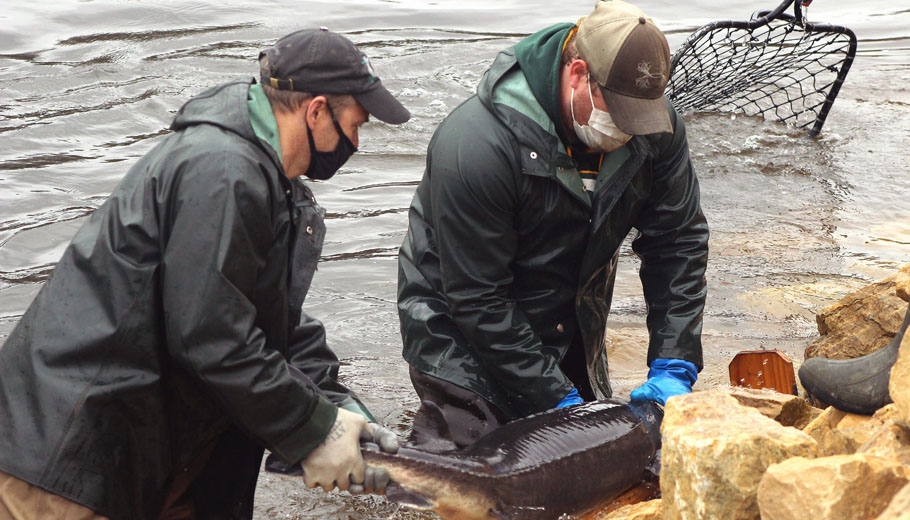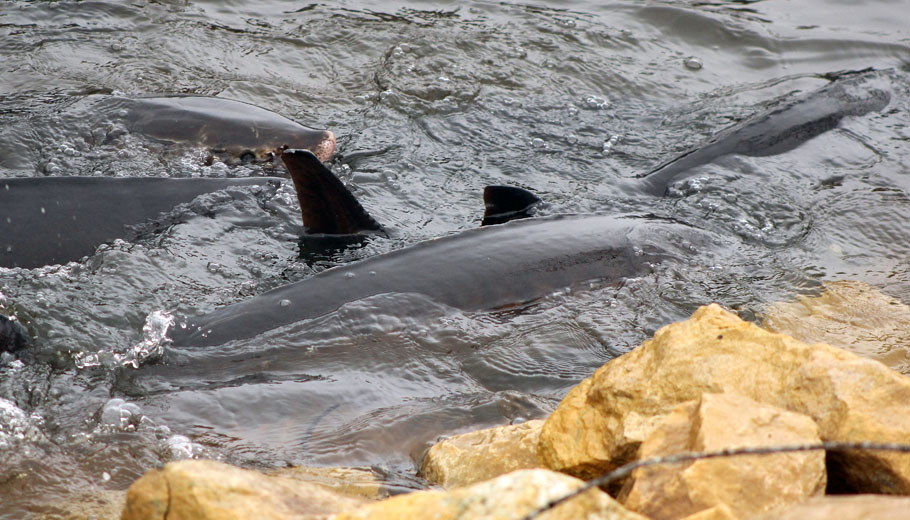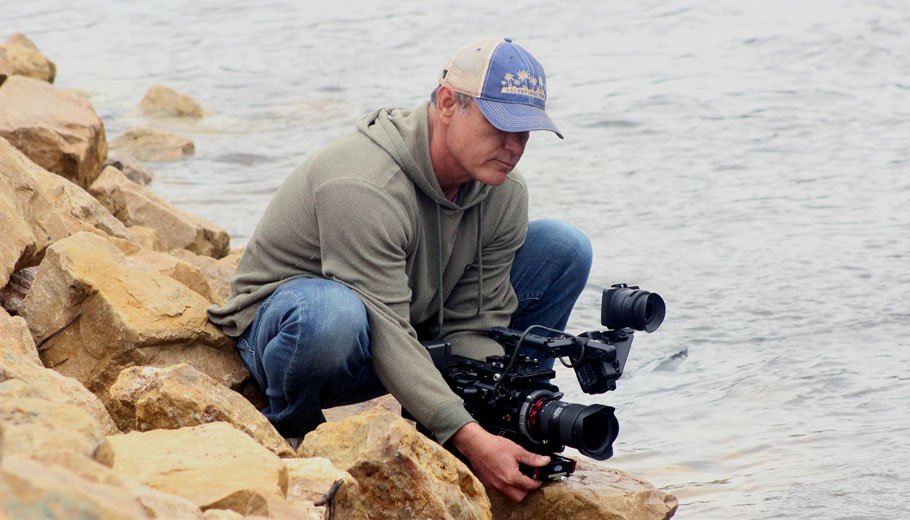Prehistoric fish part of documentary series
By Greg Seubert
The big crowds may not have been there, but the sturgeon were.
Hundreds of lake sturgeon made their way from Lake Winnebago to their spawning grounds along the Wolf River and arrived along the Wolf River Sturgeon Trail west of New London April 7.
Scott Snider and his cameras were waiting to record the action.
He arrived in New London April 8 from his home in South Carolina to shoot video for an upcoming documentary series about the Great Lakes.
Meanwhile, Aaron O’Connell, a sturgeon habitat biologist with the University of Wisconsin-Stevens Point and the state Department of Natural Resources, worked with a DNR crew that captured, tagged and released fish along the trail, which follows County Trunk X.
The annual spawning ritual typically attracts large crowds along the trail, but that wasn’t the case.
“I think there would be a bigger crowd here if it weren’t for the rain today,” O’Connell said. “We’ll see if it picks up over the remainder of the week and into the weekend. They’re just starting here and I think when these sites really start going, people will come out and view.”
On the move
Water temperature triggers the spawning activity, in which sturgeon – some of them more than 6 feet in length – spawn along the river’s rocky shoreline.
“Usually, we’ll start seeing fish cruising around 52 to 55 degrees,” O’Connell said. “The water temp right now is 60, so it was a really quick increase. It took them a minute to get going, but they’re going now. We figured today would be a big day here.”
Two four-men crews captured fish with large nets.
“We had one crew working upstream and one downstream,” O’Connell said. “This is the only place we’re at today. From what I’m hearing from wardens and other staff, it seems like this is where they’re at right now. We’re expecting them to keep going and spawning upriver as the week goes on.”
He expected fish to arrive at another popular public viewing location, Bamboo Bend in Shiocton, on April 9.
COVID-19 prevented the DNR from capturing sturgeon last year, according to O’Connell.
“We were not out last year, but we’re here this year,” he said. “We worked quite a few fish, so it was a good day. The biggest one our crew got today was just over 73 inches. We’ll definitely see some 70-plus-inch females, sometimes even 80 inches. We did have a 71-inch male today, which is an extremely large male.
“Our tagging protocols are pretty similar,” he said. “As far as sampling, we’re wearing masks and distancing to make sure we’re all safe. As far as tagging fish, we’re still tagging fish the same way.”
Sturgeon spawn in groups, O’Connell said.
“It’s usually one or two females and four to eight males around one female,” he said. “There are more males than females. Typically, if there’s one female, there are five, six, seven males.”
Captured fish are tagged and that has an impact on quotas set for Lake Winnebago’s annual spearing season, held each winter on Winnebago and lakes Butte des Morts, Winneconne and Poygan.
“Those tags are directly used to calculate our adult population and that’s how we’re setting safe harvest caps for the winter spear fishery,” O’Connell said. “Marking those fish and recapturing those fish is crucial for the population estimates we’re calculating.”
Great Lakes series
While O’Connell and his team captured sturgeon, Snider shot footage for an upcoming three-part series.
“It’s a film about the Great Lakes watershed,” he said. “My entire plan this morning was to scout four or five locations to get an idea because I’ll be doing a fair amount of work over the course of a week. I couldn’t leave this one spot. I’ve been right here because it grabs you.”
Series producer Ted Oakes of Oak Island Films Ltd. said the series’ current working title is “Great Lakes” and is scheduled to run in the spring of 2022 on The Smithsonian Channel.
Snider spent much of the day filming sturgeon as they splashed along the shoreline.
“I’m highlighting this group of fish as they move up the river,” he said. “We’re going to be building up with drones and I’m coming in tomorrow with a big underwater camera. I’m going to do that here and a bunch of other locations. I’m really just setting the stage for these guys making this move upriver in the spring, the kind of habitat that they like and the spawning event itself.”
Jeff Morales is directing two episodes of the three-part series for Tamarin Productions Inc., based in Vancouver, British Columbia, Canada.
“It’s a series about the Great Lakes and it’s for the Smithsonian Channel on the U.S. side and TVOntario on the Canadian side,” he said. “It’s about the lakes themselves, everything from the geology that formed the lakes to the animals that live in the lakes. It’s sort of a celebration of the largest freshwater environment on the planet.
“It’s a wildlife series, so we’re telling animal stories from their perspective,” he added. “In each episode, there are two or three conservation-type stories. We call them heroes of the Great Lakes, where people in conservation are trying to make the environment better. In other years, we probably would have filmed the work that’s going into sturgeon conservation, but because of covid, a lot of that has been curtailed. We’re trying to concentrate on the fish and their story.”
Morales also directed the series’ first episode last fall.
“A lot of people are familiar with the Great Lakes, but they don’t know a ton about them unless they live in the area,” he said. “It’s a good opportunity to focus on and celebrate the Great Lakes. The Great Lakes watershed is not just the lakes, but the area that flow into the lakes as well. It’s a pretty expansive area that we’re covering.
“We’re following the water flow from the source all the way to the Gulf of St. Lawrence,” he said. “We’re traveling through each lake and learning about the lakes and the animals that live there. The second episode was shot in the winter and I think they’re still shooting a little bit. That’s going to be more about how the Great Lakes were formed with glaciers and the animals that survive in the extreme conditions of winter. We’re just getting started on production for the third episode. We’re still kicking around a theme, but it’s going to be along the lines of the marvels, mysteries and monsters of the Great Lakes. We’re finding really interesting animal and plant stories unique to the Great Lakes.”
Great Lakes Monster
“This is a true Great Lakes monster,” Morales said. “It’s the largest fish of the lakes and has that prehistoric look to it. The behavior of them coming into the shallows to spawn and the spectacle of that is what we’re trying to cover. I wish I could be there. It’s all happening right there on the shore. It’s pretty spectacular.”
Snider has recorded video around the world for various nature shows.
“You’re lucky if you have an event of this size in your backyard that you can come to and enjoy,” he said. “You can’t see this anywhere else.”



